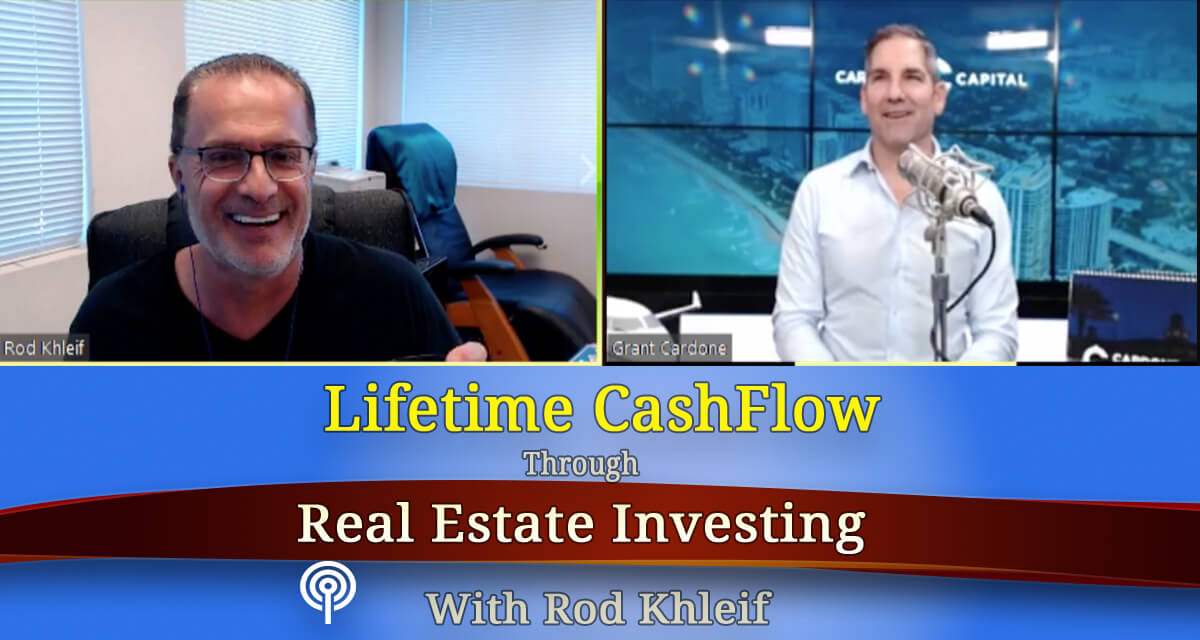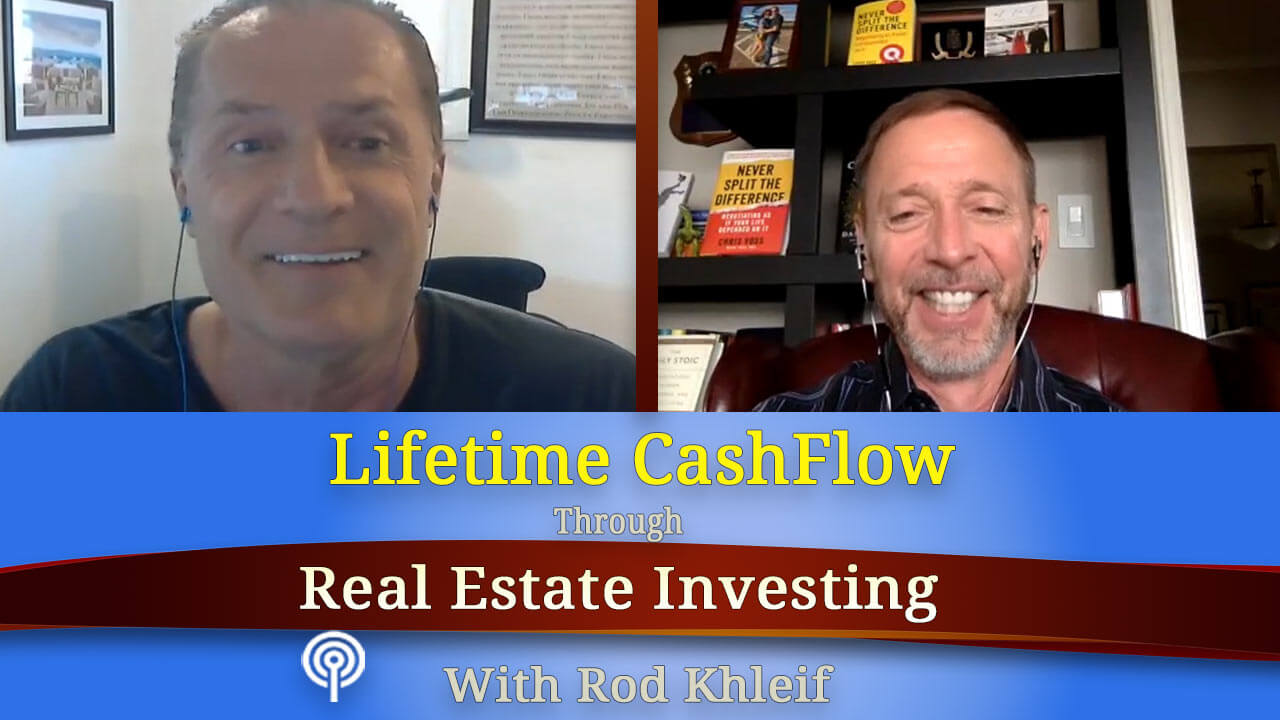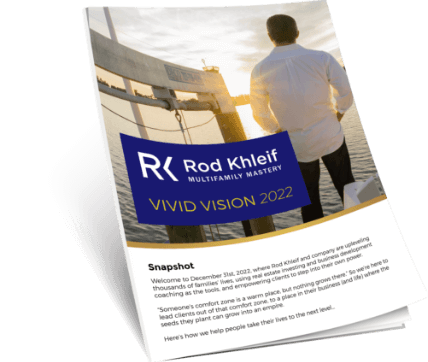Ep #614 – Why use a mortgage broker in multifamily real estate?
Adam Finkel is co-founder of Tower Capital, a Phoenix-based Commercial Real Estate Structured Finance Firm, specializing in debt and equity placement for most commercial real estate asset classes.
Here’s some of the topics we covered:
- Use a broker or go direct to lender?
- Leveraging broker’s credibility
- What stage to involve a mortgage broker
- Bridge debt
- Qualifying lenders
- Seasonal aspect of Capital markets
- DSC – Debt Service Coverage Ratio
For more information on our guest, please visit:
https://towercapllc.com/
Full Transcript Below
Rod: Welcome to another edition of “How to Build a Lifetime Cash Flow Through Real Estate Investing”. I’m Rod Khleif and I am thrilled that you’re here and I know you’re going to get tremendous value from the gentleman we’re interviewing today. His name is Adam Finkel and he’s the co-founder of Tower Capital and they are basically a Commercial Real Estate Structured Finance Firm and they’re in the capital markets and so they broker all sorts of different types of loans for this exciting business that we’re in. Everything from agency debt to bridge debt to life insurance. We’ll let him explain all the different vehicles that are available for financing multi-family but anyway let’s get to it. Adam, welcome to the show brother.
Adam: Great. Thanks, Rod. Happy to be here. Thank you for the introduction. So, yes so, my name is Adam Finkel, I’m the co-founder of a Scottsdale-based Commercial Real Estate Finance Firm called Tower Capital where we financed a myriad of different commercial real estate assets. Multi-family being our bread and butter and really under all different types of different situations. So whether it’s someone buying a stabilized property or maybe they’re refinancing. If someone’s buying a transitional value-add asset. We also finance ground-up development you know and that’s here, you know, in Arizona throughout you know, really throughout the United States, we’re pretty active. I think we’ve closed deals in about 28 states so far. So since it’s–
Rod: Very nice. Very nice. Well, welcome buddy. Yeah, so let’s get into some things here and before we get started really, I want to talk kind of an overarching comment about dealing with brokers versus dealing directly with lenders. And so, you’re a broker, you’re basically a mortgage broker as it relates to capital for commercial real estate and I know you do other asset classes as well besides multi-family. We’re going to focus on multi-family. So guys, I’m going to tell you that I’m going to encourage you to utilize a broker versus going directly to a lender. And Adam, I’m gonna let you explain why. Because you’ll do a better job than I will.
Adam: Sure. Thanks, Rod. Well, you know, there are really many different reasons to use a broker. And even in my own life for my own needs, I use brokers for things because they have the, you know, the day-to-day expertise. You know, the capital markets are always changing. You know, rates are changing. You have, you know, new lenders coming into the market. You have lenders exiting the market. You have lenders coming out with new programs or modifying programs or changing the leverage or changing how they are doing their underwriting stresses. And this is happening constantly, every single day. And, you know, it seems even you know, as time goes on things change more rapidly. You know, not both in finance and life in general. I feel, lately. But, it’s really important to have, you know, an active broker that is in constant contact with all of these different capital sources and you know, really having a pulse on what’s happening today, you know. Another reason for using a broker is just the surety of execution and making sure that things go smoothly and really maximizing your loan terms. You know, I’m working with these different capital sources every day. I understand how they underwrite. What they like to see, what they don’t like to see. You know, what they’re looking for in a borrower and you know, we can massage the package and create the package in such a way to really accentuate what they’re looking for and maximize you know, either if it’s loan dollars or try to get the best rate or whatever it may be. In addition to that, being able to create some competition in the marketplace and being able to send a deal out to a bevy of qualified lenders and create some competition in order to get, you know, the borrower the best terms.
Rod: Yeah. And let me interject something. Let me interject something on that. So guys, if you go out there and present a deal to multiple lenders or multiple brokers for that matter you’re going to get a bad reputation because there’s a lot of work that goes into evaluating a deal versus using a broker. You know, like Adam, and allowing him to present it. Would you expand on that or do you agree or disagree with what I just said?
Adam: Yeah. Absolutely. I mean, you know a lot of times it’s– I just kind of need someone to sit back and let me do my thing. And you know, I would definitely say you know someone should be cautious of using you know, trying to use multiple brokers because the lenders are all very, very, busy especially nowadays and when they see the deal coming in from multiple people they say, okay, well, no one has control over this and they’re just not going to pick up the file or they’ll just put down the file. So, you know again, you know, important to you know, pick a horse and go with them. Someone that you’re comfortable with and you know, it’s you know, one of the things that are made us successful is you know, having credibility with the lenders and when we bring one of our client’s deals to a lender you know, we’re gonna have a nice package put together, we’re gonna have all the information that they need, we’re gonna have a nice executive summary on the asset on the area on the borrower, we’re gonna have you know, this all the supporting documentation. We’re gonna have provided our own underwriting, you know, the sales comps, the rent comps, and so, you know, we’re really putting that all together and you know, the lenders appreciate that and you know, so someone like myself you know, they’re going to be looking at my deals whereas maybe, they might not be looking at other people where you know, there’s maybe they think the person doesn’t ever have control or you know, they’re just throwing something together. So you know, just having a really active broker I think is important.
Rod: Yeah. Yeah. So let me ask you a question. When should someone engage you or get you involved? At what stage in a deal do you suggest being contacted and start you know, start a relationship. Well, in fact, that’s two things at one point you know, obviously you probably want to start a relationship first. Get to know somebody, have them contact you, and just spend a little time chatting with them. But at what point do you want them to bring you a deal?
Adam: Sure. Absolutely. And that’s a great question. You know, time is our friend and you know when people don’t leave themselves enough time you know, that’s when you can lose you know, negotiating leverage or just get stuck in a bad situation. So, we always want people to be proactive and give us more time than less time. So what does that mean? Generally, for me that means, you know, you’ve already internally looked at the deal, you’ve underwritten the deal and, you know, you think it has logs. and then you send it over to me and you say hey, Adam you know, I really like this deal. I like the location, we underwrote it, it looks good. You know, we think we can hit the leverage that we need, you know, can you give it a glance over and what do you think. You know, maybe the person’s getting ready to put in an offer or you know maybe they could even be going back and forth on an LOI and they think maybe they’re getting close, and hey, we’re getting close on this thing. Now, can you take a look at it so, you know, I’ll say, great, send me you know, the OM or whatever marketing you know, package there is on the property? Send me a trailing 12-month operating statement. Send me the rent roll. And those are kind of the three basic things that I need, you know, to underwrite the deal. Give it a quick underwriting, turn that around 24-hours, and what I do is, I underwrite the deal. And I look at it and I see you know, what is the underwritten in place, LOI. You know, what do I think they’re coming in for leverage and I’ll have a conversation with the borrower and I’ll say hey, Mr. borrower, the deal looks great. I’m hitting about, you know, 75% LTV. It looks like you’re buying it on an in-place you know, six Cap, which is fantastic and you know, I think, you know given your parameters of wanting a long-term, non-recourse, fixed-rate loan you know, I think, you know, we could go, Fannie, we can go Freddie. Here’s what the rates are looking like for, you know, a 10-year fixed rate. And we can discuss some different structures and then you know, they can continue to negotiate. They win the deal, great. You know, they pick a horse, I go out and get a formal term sheet or loan application for whatever that lender may be and it’s off to the races.
Rod: Nice. Nice. Nice. Yeah, so yeah. I know that in your house you do like I said, you do conforming debt. You probably, I assume you do CMBS when it’s around. You do Life Insurance, you do every– all the above but also, you also place bridge debt as well. Is that correct?
Adam: Yes, right. Yeah, we do a lot of bridge debt.
Rod: Right. Right. So, let’s talk about that for a minute. Now, guys you know those of you that are brand new to get conforming debt you need to be 90% physically occupied for 90 days. 90 for 90. Remember that. But, you know, if you have a property that’s not at that place then you’re likely going to need bridge debt and to do your value-add play and then ultimately refinance into hopefully some agency debt. So, you know, as it relates to bridge debt you know, can you talk about some of the different scenarios you’re seeing right now, terms, situations, just expand on this, you know, just take it wherever you want to take it as it relates to bridge debt.
Adam: Sure. Absolutely. Well, you know, there are a lot of options for bridge debt right now and really it can range from you know, your local hard money lender to more of these you know, larger debt funds that can be backed by you know private equity groups or you know, they can even be backed by life companies in all different places. You know, or you have you know, the traditional lender such as you know, the banks that maybe they have some kind of you know bridge program. You know, typically that’s going to be a recourse loan versus a non-recourse loan with the debt funds. You know, really, when I’m looking at a property and it’s we’re looking at a bridge situation, there’s a couple of different variables that are going to direct what type of bridge lender. First is, how large is the loan? A lot of these debt funds, you know, they don’t want to write a check that’s less than 10 million or 15 million dollars, and the larger more institutional ones you know, some of them, they don’t want to write a check under 50 million dollars. You know, obviously, those are going to be the lowest price you know, the cheapest money is you know, those the larger deals, the larger you know debt funds. You know, then you have you know at the other end of the spectrum, you know, if you’re dealing with a smaller property and maybe you’re only talking like a three or four or five million dollar loan, you know, sometimes it’s easier to go to the local private money person where you know, yeah, they’re charging high single digits and a couple of points but you know, they’ll close in two weeks, they’re not ordering all the third-party reports, you don’t have a big lender legal bill. You know, that you’re gonna get hit with. So, you know, that’s really the thing is. Sometimes, people can, you know, be attracted to you know, these debt funds and they hear the money’s really cheap but then you know for certain situations it really doesn’t. You know, it doesn’t really add up. You don’t have the economies of scale you know, with all the fees and some other things that you know, come into that. So, you know, just really understanding you know what’s the size of the deal and then also how heavy of a bridge is it? You know, is there any cash flow that’s in place? You know, maybe there’s cash flow and it can cover a 1-O debt service but it just has 20% vacancy instead of 10% vacancy. Or is it a property that maybe you’re converting it from a hotel or a student housing to a multi-family and it’s going to be completely emptied out and maybe like some of the mechanical systems need to be adjusted. I mean, that’s going to be a very heavy bridge where you know, you’re going to need a certain type of lender that’s comfortable with you know, an empty building for a certain amount of time, and in those cases, they’re building in interest reserves you know, into the loan that will cover the debt service during that period where there’s no cash flow. You know, and those lenders are going to typically be a little bit higher price lenders than you know, a very light value-add bridge where there is some cash flow and maybe you could even go to a bank and get a, you know, a bank to do it. You know, for you know, a very low rate. So, you know, just really just depending on the situation, you’re just trying to match that up with the group that’s going to be the best fit.
Rod: And, you know, I’ve heard this expression around bridge lending and that is, it can be a little bit of the wild, wild, west and there you know, there are some unscrupulous players in that arena as well. And I have an example with one of my students that I had a commitment letter from a bridge lender that bailed a day before closing and they ended up buying the asset. The bridge lender did. Now, they said they can’t speak to the exact deal but you know, would you agree that you definitely want to work with, you know, somebody that has had experience with a particular bridge lender, knows how they operate, knows that they’re for real. Know that you know, that they deliver on what they promise. I mean, do you want to speak to that at all?
Adam: You know, that’s really, you know, great insight and really, no matter what type of lender you’re working with, you want to, you know, make sure that they’re qualified. They’re active, they’re doing those types of deals who, have they lent to before. What was the experience? Because you know, you can have, you know, the local shading private money guy you know, that is you know doing you know, bad things or you can just have a bank that they’re so darn slow and their process is terrible and you know, they’re issuing a term sheet and the credit person hasn’t looked at it and they drag you out for three months and then the credit guy says, I don’t like the deal and then they’re knocking $500,000 off your loan. That’s a bad experience too. So really another– just another reason to be utilizing an active broker where you know, they know what lenders are good you know, who is executing. You know, we’re part of a, you know, although I’m an independent shop, I’m part of a National Group of Independent Commercial Mortgage Bankers and Brokers like myself where we do information sharing and we get on a call every two weeks and we have a new lender and you know if someone’s dealing with the lender that they haven’t heard of they shoot an email out to the group hey, has anyone heard of this under, has anyone dealt with these guys, what was the experience. So, yeah. I mean, look, it’s– and even you know in my own business, when I’m taking a client to a lender that I’ve never worked with, you know, I always have some hesitation and I really try to get a good understanding of what is their process, what’s their approval process, who has looked at the deal so far, what other information are you going to need. What’s your timeline and you know, really try to make sure we get a full understanding of all those things.
Rod: Well, that’s really good. That’s great. So, can you talk about what’s happening right now in the capital markets? What you know, pricing things like that. Just what are you seeing right now and you know where we are, we’re in the fourth quarter. Things normally slow down this time of year. Maybe you can speak to that as well. You know, a seasonal aspect of the capital markets as well.
Adam: Sure. Sure. You know and I think that you know, most of the lenders have been running pretty hard this year. You know, everyone kind of took their foot off the gas and took a step back last year, you know, in the heat of COVID. You know, now with things coming back you know money has to be placed and obviously there are certain markets in the country that you know, the lenders and the equity groups are gravitating towards you know, typically those are going to be you know, kind of like the warm weather smile states they call them. You know, they are still very attractive. You know, really a lot of the markets that are seeing, you know, an influx of population growth, you know, Texas, Florida, Arizona, Denver, you know, Salt Lake, you know Carolinas. You know, so the lenders, they like those deals you know, if you’ve got, you know, a multi-family project in any one of those markets you know, they’re hungry for that, obviously. There’s a big lack of supply of multi-family housing. It can be in a lot of these markets so–
Rod: Right.
Adam: The lenders want to be putting money out in that asset class. You know, I know we’re focused on multi-family but just real quick. The other big asset class that the lenders are looking to put money in is industrial as well, kind of an under-supply there. So, kind of, these two asset classes are very popular. The rates, obviously, remain at all-time lows. You know, both for long-term debt, you know, and short-term debt, you know, the bridge lenders are very aggressive and you know, very hungry to try to get deals. While at the same time, due to all of the transactional velocity and the volume, you know, we are starting to see you know some of the spreads widening. Some of the lenders are becoming more selective, you know, with the deals that they’re doing and everything. So, we are starting to see a little bit of a pullback although it’s still you know, in comparison to, you know, past years you know, it’s the pricing, it’s the terms, are very, very attractive right now you know, for borrowers. For bridge don’t let loans for shorter-term debt you know 75 to 80% of project costs you know, that would typically include your purchase price plus cost of any capital improvements. Some lenders will allow you to include you know, developer fees or you know certain you know fees in there some will want to net that out. You know, some of the lenders, you know, we’re even getting up to, you know, 85% loan to cost, you know some of them will say well we’ll finance 80% of the purchase price in a 100% of the CapEx. You know, you’re seeing you know some of the lenders offering these stretch senior loans again where they’re basically holding an internal A note and B note to provide higher leverage at, you know at a blended rate. So, you know, the lenders are very aggressive again on the conventional side with the agencies and then even the banks to some degree. You know, they were holding back a lot of reserves, extra reserves from COVID you know, that has you know run away. You know, Fannie, isn’t doing it anymore. I think Freddie, in certain situations, may have you know some COVID reserves. The banks, I’m not seeing COVID reserves from the banks anymore. So, you know, the lending environment has certainly loosened back up in that regard while at the same time you know, the lenders are maintaining their underwriting requirements so they’re still wanting to see a minimum debt service coverage ratio and or a debt yield. So, they’re still very focused on that.
Rod: Let me interrupt you. Let me interrupt you for one second. Just see. You guys, some of my listeners are brand new and that debt service coverage ratio is the property’s ability to service the debt and he mentioned that earlier when he said some bridge lenders you know might want to see a 1-O debt service coverage ratio and that just means it’s an annualized number based on the property’s ability to service the debt. So, you take the net income, you compare it to the annual debt service, you know, if you’ve got a hundred thousand dollars in net income and a hundred thousand dollars in debt service for the year that’s a 1-O. Most lenders want to see a 1.25 debt service coverage ratio. So they want to see $125,000 in net income or even a little more depending upon markets. Correct me if I’m wrong on this, Adam and 125 is typically the minimum for agency debt unless it’s in an area that they consider, I forgot what the term is. Which–
Adam: Primary market.
Rod: Yeah. They want that, you know, if it’s not a primary market that you know that’s– you said something else that I wanted to expand on yeah, I forgot.
Adam: So, yeah. But that service coverage ratio is very important so the lenders want to make sure that. you know, after the debt service has been paid that there’s some cushion there, for you know, unexpected things or whatever. Maybe you lose some extra tenants and they want to make sure that there’s some cushion. So that’s why generally, they’re gonna want. you know, a 1.25 that covers 125% you know, cash flow compared to the debt service. You know, typically if they’re going to be lowering the leverage, the agencies Fannie and Freddie, they go on a tiered system. So basically, they call it tier-two is full leverage at, you know, 75 or 80% LTV that will be a 1.25 debt cover. The next tier, tier-three, is going to be at 65% LTV and that will require a 1.35 debt cover, so they want to see a little bit more debt cover at the lower leverage but you’re also getting, you know, more attractive pricing and maybe some additional years of interest only and so forth. You know, then they have tier-four which is 55% LTV. They’re going to want a 1.55 service coverage there.
Rod: Interesting. Okay, I didn’t know that. It’s very uncommon to see that kind of you know, that kind of loan to value unless you know, probably big players that get into the arena that have lots of liquidity. But, fascinating. Yeah. So, just trying to think if there’s any other thing I want to ask you about. But you know guys, you know, check– what’s your website, Adam?
Adam: Sure. My website’s www.towercatllc.com.
Rod: Gotcha. All right. Well listen, I really appreciate you being on the show and you know this is a topic that even for me sometimes a little overwhelming because there’s so many little nuances and details to it. But I was mentioning to you, we just closed on our San Antonio asset here, a few days ago and it was– we got like 3.2 interest rate, five-years IO, and just incredible. I mean, I remember, I’m old, I’m 61. I remember when 7% was like a home run for interest rate and now we’re you know at 3-2 it’s just unbelievable how awesome the rates are right now and by the way guys, I don’t know when this episode will air, but I think we actually still have a few slots left in that screaming deal. It actually breaks even on day one at 40 again right now it breaks even at 41% vacant. Economically vacant. Which is very unusual in this market and you know most of the deals that are being done right now by operators are 70,30 splits or 80,20 splits and we’re at a 50,50 and we still have a, you know 10 to 12% cash on cash, 15 plus IRR on this deal. Just because it’s such an incredible deal. So, you know, if you’re interested text the word “PARTNER” to “72345” and even if that one has fully subscribed, we’re doing some post-closing subscription just because Scott, my partner, and I have been so busy with live events and stuff but if you text “PARTNER” to “72345”, we can let you know about the next one if that one’s fully subscribed but anyway, Adam, I appreciate you coming on the show my friend, you’ve added a lot of value and I’m sure that we’ll stay in touch now that we know each other and talk soon.
Adam: Perfect, Rod. Will hey, thank you very much. Have a great weekend and I appreciate the opportunity.













